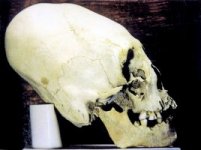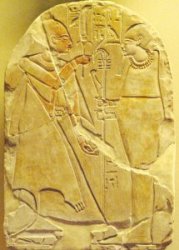
 Skull deformation - or
scientifically called: "artificial cranial deformation" - was a
custom that which had been practised in the past by various groups
worldwide, in Asia, Africa (e.g. Egypt), Indonesia, Papua New Guinea,
Melanesia, Polynesia, Australia, the Americas (e.g. the Chinook and
Choctaw, the Olmecs, Maya and Inca), China, Korea, the Huns and Alans
in the Old World and the East Germanic tribes in Late Antiquity. Among
the Chinooks, it was a sign of good mothering, and in some other
cultures it was a mark of status.
Skull deformation - or
scientifically called: "artificial cranial deformation" - was a
custom that which had been practised in the past by various groups
worldwide, in Asia, Africa (e.g. Egypt), Indonesia, Papua New Guinea,
Melanesia, Polynesia, Australia, the Americas (e.g. the Chinook and
Choctaw, the Olmecs, Maya and Inca), China, Korea, the Huns and Alans
in the Old World and the East Germanic tribes in Late Antiquity. Among
the Chinooks, it was a sign of good mothering, and in some other
cultures it was a mark of status.
 It
is known that skull deformation comes from binding
the backside of the skull at early age to let it grow upwards in that
desired shape (it normally grows to the back because of gravity). But
there
also had been found skulls which don't show any signs of artificial
deformation, like with certain skulls of one year old infants and even
yet unborn children from ancient Peru - where the binding process
couldn't have started yet. The jaw of these skulls is much more
prominent compared to
a normal human skull and the top of the skull does not have the usual
three plates.
It
is known that skull deformation comes from binding
the backside of the skull at early age to let it grow upwards in that
desired shape (it normally grows to the back because of gravity). But
there
also had been found skulls which don't show any signs of artificial
deformation, like with certain skulls of one year old infants and even
yet unborn children from ancient Peru - where the binding process
couldn't have started yet. The jaw of these skulls is much more
prominent compared to
a normal human skull and the top of the skull does not have the usual
three plates.
Depictions of the Egyptian pharaoh Akhenaten also show babies that seem
to
already have long craniums. There are many depictions from various
ancient cultures where kings, queens, gods, and other leading figures
that are shown wearing tall headgears, and perhaps these were
originally used just because of their tall heads.
What
was actually the original reason for the deformation of skulls? Could
this practice have been the mimicking of people who looked different
to ordinary man? And could
there be, apart from being a mark of higher status, another practical
use for having such long heads, such as the possible belief that the
brain could have more room to grow bigger, so that one would
perhaps become just as gifted as the "gods" they were possibly
mimicking?
|
|
|



